
Six years ago, the United Nations General Assembly created 17 Sustainable Development Goals (SDG) that sought “to end poverty and hunger everywhere; to combat inequalities within and among countries; to build peaceful, just and inclusive societies; to protect human rights and promote gender equality and the empowerment of women and girls; and to ensure the lasting protection of the planet and its natural resources.” A bit more ambitious than your weekend to-do list. They did, however, give themselves until 2030. At a more local level, at the University of Rochester, the SDG inspired the 2021 Innovation Challenge (previously, the COVID-19 Challenge).
In the spirit of prosperity-for-all, this year’s challenge tasked 20 Rochester student teams with creating sustainable, empowering solutions for the problems that local businesses and organizations currently face. Each team was assigned one of six community partners:
- City Roots Community Land Trust
- Foodlink
- Girls Rock! Rochester
- M. K. Gandhi Institute for Nonviolence
- Seneca Park Zoo Society
- Taproot Collective
After 14 days, when all of the ideating, workshopping, and pitching was done, three winners were chosen.
FIRST PLACE: Dream Team
Team members: Afnan Ahmed ʼ21 and Rusama Haque ʼ23
Community partner: Foodlink
Problem: How do we increase the number of WIC-eligible families at the Curbside Market while creating a positive shopping experience?
Solution: Attract more WIC-eligible families through targeted marketing that includes social media and printed pamphlets and flyers while employing tactics such as surveys, raffles, and point-of-sale efficiency to retain customers.

Initially, Ahmed and Haque did what most teams did: they met with their community partners and asked them basic questions about their services. But that wasn’t good enough.
“We realized that understanding the services would be a challenge at a distance,” Haque says. “So, we went and visited the curbside market and spoke to the customers.”
The on-site visit gave them critical insight—like how long it takes a WIC customer to check out compared to any other customer—that helped them develop their approach to solving the problem. Overall, the challenge opened their eyes to the hardships and adversity some people face and the services that are actively helping them.
“Learning about the other community partners and how they’re making a difference was awesome,” says Ahmed. He went on to express how valuable the experience was and offered a “just do it”-type to those on the fence about participating in the next challenge. “I feel like most people don’t do it because they’re afraid of pitching an idea. Don’t be scared. You have to start somewhere. This is how you get there and develop that confidence.”
Haque, whom Ahmed convinced to join, knows about that fear. At first, she didn’t feel “good enough,” but then found how much she underestimated herself.
“We’re all smart,” she says. “Everyone has the ability to do great. Once you start the process, you realize that you have more potential than you know.”
Grace Adams, programs assistant at Foodlink, says she was impressed with how the team centered their pitch on the different types of people the Curbside Market serves.
“Working with Afnan and Rusama was wonderful,” Adams says, “and really helped our team brainstorm and think about our processes to make the Curbside Market even better.”
SECOND PLACE: Space Monkeys
Team members: Danielle Getz ʼ23, Sophia Samantaroy ʼ24, and Rebeca Zapiach ʼ23
Community partner: City Roots Community Land Trust
Problem: We need a process that allows our commercial storefront and rental housing property (at Parsells Avenue) to be developed by and for the community it serves.
Solution: Generate excitement and participation through in-person events (block parties, student design competitions, and workshops) and on-site marketing (engaging site-specific posters and feedback boxes).

Before you can help solve a problem, you have to understand it. And for the Space Monkeys, that was part of what made this a challenge.
“The most difficult part was contextualizing and framing the problem,” Zapiach says. “We spent most of the first week taking time to listen to City Roots.”
Samantaroy, who participated in last year’s innovation challenge, added that a lot of their ideation came from “gaining an understanding of the needs” of those that City Roots serves.
But Getz believes the hardest part was culling the best solutions from their brainstorming. “We had a lot of really fun ideas we wanted to run with,” she says, “but it was a five-minute pitch. That really limited what we could do.”
Graham Hughes, special projects coordinator for City Roots, was impressed with the team from the start.
“They were asking very specific, detail-oriented questions about every aspect of our organization, including the problem we were trying to solve,” Hughes says. “This showed me they were thinking through this deeply and holistically. It was also just wonderful to see them learn and grow throughout the process.”
While each team member found the experience rewarding, it particularly affected Getz, who was inspired to register for the XPRIZE for carbon removal with another Rochester team of undergraduate students.
THIRD PLACE: Peace Partners
Team members: Christy Bresnahan ʼ25 and Sneha Prakash ʼ25
Community partner: M. K. Gandhi Institute
Problem: How do we increase and support the community’s engagement in cultivating our gardens so we can address the food desertification in the Plymouth-Exchange neighborhood?
Solution: Employ easy-to-execute tactics focused on outreach (print marketing, social media, and an interactive Google calendar) and events (composting projects and educational offerings) to bring the community together.

Like underdog stories? You found one. Bresnahan and Prakash hadn’t even experienced their first classes as Rochester students when they took on this challenge.
Bresnahan notes they felt a bit adrift at the start. “I think, as first-years, we thought there would be more guidance on what [the Gandhi Institute] was looking for,” she says.
The team’s inexperience was also a nagging presence.
“At times, I felt we were taking the wrong approach,” says Prakash, “or that our solution was too simple.”
But none of these factors was a match for their determination and creativity, which their community partner noticed. Chyna Moorehead, youth educator at the Gandhi Institute, said their garden staff “are able to look toward the future with fresh eyes, using the ideas that Sneha and Christy suggested.”
The Peace Partners split a $500 prize, with first and second place teams splitting $1,500 and $1,000, respectively. Then there are the invaluable takeaways, which are different for every participant. For Prakash, those are “learning several new skills, learning about resources on campus, learning about the local Rochester community, and also, making a new friend.”
Not a bad way to start college. ∎
The Innovation Challenge is a collaboration between the Ain Center for Entrepreneurship, Barbara J. Burger iZone, Center for Community Engagement, Grand Challenges Scholars Program, Greene Center for Career Education and Connections, and Studio X. For more information on the challenge, contact Zoe Wisbey, program initiatives manager for iZone, at z.wisbey@rochester.edu.
Enjoy reading about the University of Rochester Libraries? Subscribe to Tower Talk.

